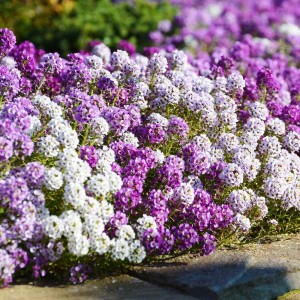 When I think back on my father’s garden, lots of flowers and plants come to mind—the huge rhubarb in the very back, the Johnny jump-ups that jumped up through the grass every spring under the pine trees, and the long row of pink, rose and white peonies that grew by the back walk. The property left the family long ago, and my father left this earth sometime after that, but I can still picture the entire layout.
When I think back on my father’s garden, lots of flowers and plants come to mind—the huge rhubarb in the very back, the Johnny jump-ups that jumped up through the grass every spring under the pine trees, and the long row of pink, rose and white peonies that grew by the back walk. The property left the family long ago, and my father left this earth sometime after that, but I can still picture the entire layout.
Fragrant flowers are masterful at conjuring memories, and my father’s garden came back to me last week by way of sweet alyssum, known botanically as Lobularia maritima. It is a small, low-growing annual plant with narrow green leaves. When alyssum blooms, the leaves are almost hidden under masses of tiny flowers that exude a fragrance whose sweetness is reminiscent of fresh hay and honey. The four-petaled blooms are white in the species, but, thanks to breeders, may also be lighter or darker purple, pink or even apricot in commercially available varieties. Sweet alyssum is generally sold in single or mixed-color flats alongside the other summer bedding plants.
Given the alluring scent of sweet alyssum, or “sweet alison”, as it is occasionally called, it is somewhat surprising to know that it is part of the vast mustard or Cruciferae family, which also includes smelly—at least when cooked–customers like kale and broccoli. The less assertive alyssum is more closely related to other attractive ground huggers like arabis and aubretia.
The Latin name combines the prosaic with the romantic. “Lobularia” comes from “lobulus”, which describes the plant’s small seed pod. “Maritima”, from the same root as “maritime” or pertaining to the sea, refers to the species’ native habitats along the sunny coastlines in the Mediterranean, Canary Islands and Azores.
Even plants that are far removed from their species ancestors tend to favor conditions enjoyed by those forbearers. In the case of alyssum, that means a sunny location and well-drained soil. Unfortunately, for those of us who live in places with hot, sticky summers, alyssum tends to sulk in high humidity situations. Providing ample moisture helps, as does shearing the plants back after they flower. Like most of us, alyssum revives in early fall when both temperatures and humidity levels go down, and will continue to put on a good show until hit by hard frost at the end of the growing season.
My father used masses of sweet alyssum to edge his rose beds. The low-growing mounds made a nice contrast with the taller silhouettes of his hybrid tea roses, and the alyssum was in bloom much more frequently. If the roses were the divas of the garden, the alyssum was the reliable chorus—never obtrusive, but a vital part of a successful production.
Depending on where and when you shop, you can buy numerous alyssum varieties. Heirloom types, which you can grow from seed, include, ‘Benthamii’, with white flowers; ‘Paletta Mix’, a medley of white and purple shades; and ‘Rosie O’Day’ with pink blooms. If you prefer to buy your alyssum in flats, try ‘Snow Princess’, a sterile hybrid that was bred to be more heat and humidity tolerant than other commercially available varieties. I have also seen the ‘Easter Bonnet’ mix in garden centers, which combines plants with white, shades of purple, and rose.
In the Victorian language of flowers, alyssum represents “worth beyond beauty”. The blossoms have unquestionable beauty, but perhaps the worth is best understood by the bees and other pollinators who are drawn by the promise of nectar. Deer and other varmints are allegedly repelled by the little plants, which is another definition of “worth beyond beauty”.
Container gardeners need not feel left out of the alyssum parade, as the plants work very well as fillers in large containers. They also thrive in sunny window boxes, as long as they are watered regularly.
At this time of year, you can find flats of sweet alyssum in just about every retail establishment with a good selection of bedding plants. To obtain seeds of older varieties, try Select Seeds, 180 Stickney Hill Road, Union, CT 06076; (800) 684-0395; www.selectseeds.com. Print catalog available.
